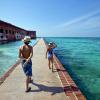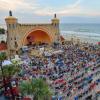The United States Civil Rights Trail invites you to follow the course of the movement and walk in the footsteps of giants, with more than 100 sites across 15 states that played key roles in advancing social justice in the 1950s and 1960s.
The trail project, which launched in January 2018 on Martin Luther King Jr. Day, covers historically significant schools, churches, courthouses and museums, including some of the best-known flashpoints -- the school desegregation in Little Rock, Ark.; a segregated lunch counter in Greensboro, N.C.; and the voting rights protests in Selma, Ala.
Here are the locations of Florida’s six sites on the trail. Follow the links to the United States Civil Rights Trail for more information on each locale.
PANAMA CITY
The Bay County Courthouse in Panama City, Florida, was the site of a 1963 landmark case that changed our nation’s court system. In Gideon v. Wainwright, the Supreme Court expanded civil rights when it ruled that the Constitution requires states to provide defense attorneys to criminal defendants charged with serious offenses who cannot afford lawyers themselves. The case began with the 1961 arrest of Clarence Earl Gideon, who was charged with breaking into a Panama City pool hall and stealing money from the vending machines. At trial, Gideon, who was unable to pay for a lawyer, requested that an attorney be appointed to represent him. He was told by the judge that the state of Florida provided attorneys only to indigent defendants charged with crimes that might result in the death penalty if they were found guilty. After he was sentenced to five years in prison, Gideon filed a habeas corpus petition (or petition for release from unjust imprisonment) with the Florida Supreme Court, claiming his conviction was unconstitutional because he lacked a defense attorney at trial. After the Florida Supreme Court denied his petition, Gideon appealed to the U.S. Supreme Court, which reviewed his case in 1963.
The Supreme Court agreed with Gideon. It ruled that the Constitution’s Sixth Amendment, which states “in all criminal prosecutions, the accused shall enjoy the right . . . to have the assistance of counsel for his defense,” gives defendants the right to counsel in criminal trials where the defendant is charged with a serious offense.
ST. AUGUSTINE
St. Augustine, Florida, drew national and international media attention in the spring of 1964 when civil rights activists were arrested and violently assaulted as they protested segregation laws. The city’s ugly and aggressive resistance to equal rights for Black Americans represented the final stage of what has been called “the great moral drama,” which culminated in the Civil Rights Act of 1964.
At the heart of the movement in St. Augustine was Dr. Robert B. Hayling, a profile in courage. Hayling was a young African American dentist and former Air Force officer who would lose his dental practice and nearly his life while leading the local struggle.
Starting in 1960, Hayling began advising the NAACP Youth Council and organized protests against segregated lunch counters. His public activism was noticed, and in 1963 he was severely beaten by the Ku Klux Klan. In February 1964, gunmen fired on his home, killing his dog and narrowly missing his pregnant wife.
Hayling was undaunted. He invited white college students to take their spring break in St. Augustine and participate in nonviolent demonstrations. In March, when protesters refused to leave a sit-in at the Ponce de Leon Motor Lodge restaurant, they were arrested and jailed. Among the detainees was Mary Peabody, the 72-year-old mother of the governor of Massachusetts. St. Augustine had become national news.
Protests and nightly marches reached a climax in June 1964 when Hayling enlisted the help of Dr. Martin Luther King Jr. and the Southern Christian Leadership Conference. On June 11, 1964, Dr. King was arrested when he tried to enter the Monson Motor Lodge restaurant.
The following week, activists retaliated by jumping into the whites-only swimming pool at the Monson Motor Lodge. Photojournalists then captured images of the motel owner pouring muriatic acid into the water, images that were broadcast all over the world. The Senate passed the Civil Rights Act the following day.
No longer able to practice dentistry in St. Augustine, Dr. Hayling relocated his family and career to Fort Lauderdale. He worked and lived there until his death in 2015.
In 2003, almost 40 years after passage of the Civil Rights Act, the city of St. Augustine recognized Dr. Hayling’s heroic efforts for racial equality and honored him by changing the name of Scott Street, where he once lived, to Dr. R.B. Hayling Place.
ST. AUGUSTINE BEACH HOTEL & BEACHFRONT
Constructed in 1939-1940 by the Works Progress Administration, the St. Augustine Beach Hotel and its surrounding structures, including the boardwalk and seawall, are recognized on the National Register of Historic Places due to their importance in social history, civil rights, commerce and entertainment.
In 1964, the Rev. Dr. Martin Luther King Jr. and the Southern Christian Leadership Conference organized nonviolent protests in St. Augustine during the city’s 400th anniversary to draw attention to the Civil Rights Act debate. The swim-ins at Monson Motor Lodge and wade-ins at St. Augustine Beach captured global media attention, helping to hasten the passage of the Civil Rights Act. Although Monson Motor Lodge has been demolished, the St. Augustine Beach Hotel and the landmarks visually delineating the stretch of beach where the wade-ins took place remain, preserving the memory of these pivotal events.
From June 17 – July 1, 1964, St. Augustine Beach was a focal point for civil rights demonstrations. The wade-ins on June 17 were successful, and by June 22, protesters faced increasing resistance. The situation escalated as police were ordered to protect rather than hinder the nonviolent demonstrators. On June 25, the Ku Klux Klan led a violent confrontation against protestors at the beach.
From the hotel to the shore, segregationists taunted protestors with derogatory chants before drawing weapons and inciting a riot. Images of the Florida Highway Patrol breaking up the riot and standing fully uniformed in the ocean to protect the protestors were among the most circulated of the entire St. Augustine movement. National media coverage of the event showed images of the St. Augustine Beach Hotel in the background, highlighted the brutality faced by the demonstrators, and galvanized public support for the Civil Rights Movement. Law enforcement reports and judicial witnesses verify that this wade-in at St. Augustine Beach proved to be the most violent day of the St. Augustine campaign. The intense media coverage and images of the incidents in St. Augustine have been widely credited for ending the Senate filibuster and expediting the passage of the Civil Rights Act on July 2, 1964.
The St. Augustine Beach Hotel and its surroundings are enduring symbols of the civil rights struggle, especially the wade-in protests that were crucial in advancing civil rights legislation. The hotel is part of the ACCORD Freedom Trail and is home to the “Waves of Change” exhibit, which showcases the impactful images from the protests. A plaque in front of the hotel commemorates the wade-ins and the passage of the Civil Rights Act, marking the hotel’s historical significance and inviting visitors to learn about this critical chapter in the Civil Rights Movement.
MIMS
Mims, Florida, a mainly rural community, may seem an unlikely place for civil rights activity. But here in the 1930s and 1940s, schoolteachers Harry T. Moore and his wife Harriette Simms Moore opened the first state chapter of the NAACP, fought for equal pay for teachers, started the Progressive Voters League, and investigated lynchings and police brutality. The Moores’ efforts for justice and equality cost them their lives when their home was bombed on Christmas Day in 1951.
As president of the Brevard County chapter of the NAACP in the mid-1930s, Harry Moore engaged in civil rights activities, striving to galvanize community support for local NAACP chapters at a time when many African-Americans were fearful of the Ku Klux Klan. His involvement with the NAACP began in 1934 and ended in November 1951, a month before his murder.
While working with the NAACP, Moore held a variety of offices – from president of the Brevard County branch to president of the Florida State Conference, which he helped found. Under Moore’s leadership, the Florida-based NAACP grew from nine to 76 active branches at its peak in 1948. For his activism, Moore, his family and friends faced constant threats from the KKK, and he and his wife were both fired from their teaching positions. On December 25, 1951, the Moores’ home in Mims was bombed, mortally wounding the two.
Their deaths propelled Harry Moore’s name and work into the media spotlight. In anticipation of the publicity that his martyrdom would engender, the NAACP’s national office launched fundraising and membership drives in Moore’s name. His death had achieved the opposite of his murderer’s intentions. Rather than silencing the activism, the murders instead moved African-American citizens to fight, this time more than ever, for equality.
VERO BEACH
Throughout Florida, civil rights victories were achieved at a gradual pace. But in Vero Beach, the Dodgers led the way to lasting change and lasting hope. Under the watchful eye of team management, led by visionaries and future Hall of Famers Branch Rickey and Walter O’Malley (and later O’Malley’s son, Peter), the baseball club welcomed players of color and set an example for the country.
Historically, Vero Beach had followed segregation laws common in the South. Then in 1947, the year before the Dodgers made this small seaside town its spring training home, Jackie Robinson broke the color barrier in Major League Baseball and changed everything. Dodgertown opened in 1948 as the first integrated MLB spring training site in the South. The Dodgers and their Montreal Royals minor league club both had African-American players staying in the same living quarters and eating in the same dining room as other players and personnel.
In a 1950 column written by “The Old Scout,” Dodgers President Walter O’Malley was quoted as saying, “Prejudices have no place in our society and certainly not in sports.” Yet segregation laws continued to be practiced in the South. The Dodgers continued to add African-Americans, and the 1954 team set MLB history by having a starting lineup featuring a majority of African-American players.
The Dodgers kept doing their part during the era of the Civil Rights Movement. O’Malley opened a pitch-and-putt on Dodgertown property in the 1950s, and then a public golf course in the 1960s so all players could play golf together. And in 1962, Dodgertown Director Peter O’Malley removed the concept of segregated seating, water fountains and restrooms from Holman Stadium at Dodgertown long before local public schools were integrated. These progressive actions that began with a baseball team went beyond Dodgertown and Vero Beach, influencing social change nationwide.
SARASOTA
For generations, Jim Crow laws made Florida’s beaches off-limits to African Americans.
After a 1951 campaign for beach access for Black residents fell on deaf ears followed by years of resistance and delays, Neil Humphrey Sr., Sarasota’s NAACP president and the owner of Humphrey’s Pharmacy, prompted residents to organize for change.
In fall 1955, Newtown residents led by Humphrey began challenging the old order by piling into cars and driving to Lido Beach. They swam, walked the shore and waded into the Gulf waters. This act introduced “wade-ins” to the civil rights lexicon.
The wade-ins drew media attention and opened an early front in the fight for equal rights years before better-known state and national victories of the 1960s. Fewer than two miles of Florida’s 825 miles of beaches were open to African Americans. It took the Civil Rights Act of 1964 to do away with segregated beaches for good.
Visitors can retrace the Newtown community’s history from Reconstruction to the Civil Rights Act as part of the Newtown Alive tour and experience the Florida Black Heritage Trail, which includes America’s Eatonville, America's oldest incorporated Black town.






















